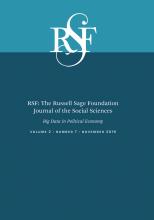Research Article
Open Access
A Data-Driven Voter Guide for U.S. Elections: Adapting Quantitative Measures of the Preferences and Priorities of Political Elites to Help Voters Learn About Candidates
Adam Bonica
RSF: The Russell Sage Foundation Journal of the Social Sciences November 2016, 2 (7) 11-32; DOI: https://doi.org/10.7758/RSF.2016.2.7.02
Adam Bonica
aAssistant professor of political science at Stanford University. He is also co-founder at Crowdpac Inc

REFERENCES
- ↵
- Aldrich, John H., and
- Richard D. McKelvey
- ↵
- ↵
- Ansolabehere, Stephen, Jr..,
- James M. Snyder, , and
- Charles Stewart III.
- ↵
- Bailey, Michael A
- ↵
- ↵Blackwell, Matthew, James Honaker, and Gary King. 2010. “Multiple Overimputation: A Unified Approach to Measurement Error and Missing Data.” Working paper. July 19. Available at: http://polmeth.wustl.edu/files/polmeth/measure.pdf (accessed May 31, 2016).
- ↵
- ↵Bonica, Adam. 2016. “Inferring Roll Call Scores from Campaign Contributions Using Supervised Machine Learning.” Working paper. Stanford, Calif.: Stanford University (Mach 12). Available at: SSRN: http://ssrn.com/abstract=2732913 (accessed May 31, 2016).
- ↵
- ↵
- ↵
- Drucker, Harris,
- Chris J. C. Burges, ,
- Linda Kaufman, ,
- Alex Smola, , and
- Vladimir Vapnik
- ↵
- Epstein, Lee,
- Andrew D. Martin, ,
- Jeffrey A. Segal, , and
- Chad Westerland
- ↵
- Gerrish, Sean, and
- David M. Blei
- ↵
- ↵
- ↵
- Hare, Christopher,
- David A. Armstrong, ,
- Ryan Bakker, ,
- Royce Carroll, , and
- Keith T. Poole
- ↵Issenberg, Sasha. 2012. The Victory Lab: The Secret Science of Winning Campaigns. New York: Random House.
- ↵Ladner, Andreas, Gabriela Felder, and Jan Fivaz. 2010. “More Than Toys? A First Assessment of Voting Advice Applications in Switzerland.” In Voting Advice Applications in Europe: The State of the Art, edited by Lorella Cedroni and Diego Garcia. Naples: ScriptaWeb.
- ↵
- ↵
- Laver, Michael,
- Kenneth Benoit, , and
- John Garry
- ↵
- ↵
- ↵
- ↵
- ↵Monroe, Burt L., and Ko Maeda. 2004. “Talk’s Cheap: Text Based Estimation of Rhetorical Ideal-Points.” Paper presented to the Twenty-First Annual Summer Meeting of the Society for Political Methodology. Stanford University (July 29–31).
- ↵
- Peress, Michael
- ↵
- ↵
- Poole, Keith,
- Jeffrey Lewis, ,
- James Lo, , and
- Royce Carroll
- ↵
- Poole, Keith T., and
- Howard Rosenthal
- ↵Poole, Keith T., and Howard Rosenthal. 1997. Congress: A Political-Economic History of Roll Call Voting. New York: Oxford University Press.
- ↵Ramage, Daniel, Christopher D. Manning, and Susan Dumais. 2011. “Partially Labeled Topic Models for Interpretable Text Mining.” In Association for Computing Machinery (ACM), Proceedings of the 17th ACM SIGKDD International Conference on Knowledge Discovery and Data Mining (San Diego, Calif., August 21–24), 457–65.
- ↵Ramage, Daniel, Evan Rosen, Jason Chuang, Christopher D. Manning, and Daniel A. McFarland. 2009. “Topic Modeling for the Social Sciences.” Presented at Neural Information Processing Systems (NIPS) 2009 Workshop on Applications for Topic Models: Text and Beyond. Whistler, Canada (December).
- ↵
- Roberts, Margaret E.,
- Brandon M. Stewart, ,
- Dustin Tingley, ,
- Christopher Lucas, ,
- Jetson Leder-Luis, ,
- Shana Kushner Gadarian, ,
- Bethany Albertson, , and
- David G. Rand
- ↵
- Rosema, Martin,
- Joel Anderson, , and
- Stefaan Walgrave
- ↵
- ↵
- Slapin, Jonathan B., and
- Sven-Oliver Proksch
- ↵
- ↵Willis, Derek. 2014. “New Voter Guide Follows the Money.” New York Times, September 1.
In this issue
A Data-Driven Voter Guide for U.S. Elections: Adapting Quantitative Measures of the Preferences and Priorities of Political Elites to Help Voters Learn About Candidates
Adam Bonica
RSF: The Russell Sage Foundation Journal of the Social Sciences Nov 2016, 2 (7) 11-32; DOI: 10.7758/RSF.2016.2.7.02
Jump to section
Related Articles
- No related articles found.
Cited By...
- No citing articles found.





